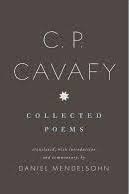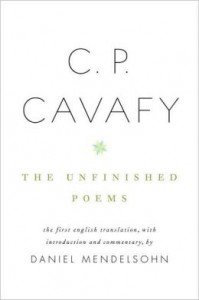 C. P. Cavafy: Collected Poems
C. P. Cavafy: Collected Poems
Translated, with introduction and commentary by Daniel Mendelsohn
Knopf, 547 pages, $35.
 C. P. Cavafy: The Unfinished Poems
C. P. Cavafy: The Unfinished Poems
Translated, with introduction and commentary by Daniel Mendelsohn
Knopf, 119 pages, $30.
OF THE THREE famous gay bachelors of literature—Henry James, Marcel Proust, and Constantine Cavafy—only one was a poet. Most people agree that Cavafy (1863-1933), an Alexandrian who wrote in modern Greek, is the greatest of the 20th-century poets when it comes to dealing with gay subject matter. It’s a thematic preoccupation that centers on the author’s own experience as well as on the lives of well-known or obscure figures from Greek and Byzantine history and literary culture.
The publication of Daniel Mendelsohn’s twin volumes presenting new translations of Cavafy’s poetry is an event that I’ve anticipated ever since he announced more than a decade ago that it was underway.
A scholar of Greek and Roman classical literature, a prize-winning memoirist, a respected cultural critic, and probably the most prominent member of the gay intelligentsia, Mendelsohn was perfectly positioned to tackle a project of this scope. The amount of effort involved, when compared to the incidental rewards that are likely to come of it, can only mean that he took up the challenge out of a profound admiration for Cavafy; and Mendelsohn’s admiration has been transformed by work into an offering that the readership for serious poetry is certain to value.
Readers of poetry are already aware that several translators have, with varying success, brought Cavafy into English. Since the 1950’s, ample selections from his poetry have been published by John Mavrogordato, Rae Dalven, and, jointly, by Edmund Keeley and Philip Sherrard. (To these one can add a handful of excellent translations made by poets James Merrill and Don Paterson.) But Mendelsohn’s new translations include all the published and unpublished poems that Cavafy wrote (including those he repudiated when he reached maturity), and three that he wrote in English. The volume titled Unfinished Poems translates thirty poems Cavafy hadn’t decided to publish by the time of his death, despite the fact that most of these can stand comparison to his best work.
In his introduction to the Collected Poems, Mendelsohn states the obvious fact that any new translation builds on the work of earlier translators, but I want to avoid the tedium of comparing successive renderings of given lines or whole poems and just say that, although earlier translators sometimes give us superior versions of some poems, in general Mendelsohn’s are the best. Not only does he strive for semantic exactness, he also works much harder than his predecessors (with the exception of Merrill) to reproduce Cavafy’s metrical form and rhymes. Meanwhile, I’m going to keep the Keeley-Sherrard volume on my shelves, partly because of its many successes and partly because it contains facing texts in Greek, which I know well enough to follow if I have a trot next to it. Critics have said that Cavafy goes easily into English, without much loss of poetic power, but the idea doesn’t hold up on close inspection. Because Greek is an inflected language, poets writing in it have more syntactical freedom than is permissible in English. Translators can certainly give the content of his poems with near-perfect accuracy. But following Cavafy’s syntax, his word-sequencing (which gives pride of place to some of the sentence components), is often impossible to reproduce perfectly in English. Cavafy uses very little figurative language and sonic ornament, replacing these with his own kind of verbal magnetism, the heft of syntax. I found it instructive to watch Mendelsohn grapple with this problem and applauded when he succeeded.
Besides an informative introduction to Cavafy’s life and work (written with more verve than we expect from textual scholars), the book also includes detailed commentary on the poems, a series of endnotes that clarify the texts’ intentions and implications. Reading them, a fascinating and informative experience in itself, you come to see that Cavafy’s poems achieve their complex meanings at the intersection of history, autobiography, diction, prosody, and an eccentric sensibility. Mendelsohn’s notes bring to light aspects of the poems that weren’t at all clear beforehand. Understanding great poems is a decades-long enterprise, made still longer when they’re written in another language; but in this instance the process can be accelerated if you keep a bookmark in the Notes section of the books.
The claim applies even to Cavafy’s most transparent subjects, those based not on history but on the author’s experience. Cavafy’s autobiographical poems are developed as mini-short stories in verse describing missed or fulfilled encounters with young Alexandrian men who are invariably presented as perfected icons of masculine beauty—though not of chastity. Ecstatic hours spent with them are suggestively rather than graphically described. Part of the intensity conveyed arises from an imposed obligation to conceal from the outside world what’s going on, a restriction that itself serves as an extra aphrodisiac. And there is another psychological source of excitation that we can discover here. Mendelsohn makes the point that for Cavafy the key historical figure is the 4th-century Roman Emperor known as Julian the Apostate, the subject of nearly a dozen of his poems. This enigmatic personality, who came to the throne half a century after Constantine had institutionalized Christianity as the Roman state religion, achieved notoriety by de-Christianizing himself and reinstating the Roman pantheon of gods throughout the Empire. (Julian is also the protagonist of a witty and gripping novel by Gore Vidal, partly inspired, no doubt, by Cavafy’s poems.)
It’s not that Cavafy simply wanted to be a pagan, with Julian set up as a poster-boy in the struggle against Christian sexual repression. What fascinated him was an experience lived out, like the apostate emperor’s, on the knife edge between paganism and Christianity. The poem “Julian at the Mysteries,” for example, depicts the addled Emperor in a moment of panic forgetting his paganism and crossing himself like a routine churchgoer. Greek Orthodox religion was part of Cavafy’s cultural heritage, something he never formally repudiated, no more than he allowed the repressive part of that legacy to interfere with lively sexual engagement and a constantly reiterated devotion to idoni, “pleasure.” What we need to reflect on is how often Cavafy adopted a repressive perspective in the nouns and adjectives he chose to describe the kind of erotic life he favored. Over and over in his poems we find terms like “debauchery” or “corruption” or “dissipation” used with relish, and gay sexual practice gleefully described as “unwholesome” or “illicit.” This isn’t the pagan view, obviously, and resorting to a pejorative diction when referring to sex implies that Cavafy found such terms stimulating.
In his day, almost no gay erotic writing was available and almost no homoerotic imagery, unless you count the nude figures found in the masterpieces of classical Greek sculpture or vase painting. It’s more than probable that Cavafy found his own poems erotic; when he adopted a vocabulary based on Christian moral norms, it was like adding chili to the sauce, so that a sense of transgression might double the voltage of sexual experience. Just possibly the perverse eroticism of the poem titled “The Bandaged Shoulder” has a basis in Christian theology, too, since it develops the erotic potential of shed blood. It concludes with a tableau of the narrator holding a scrap of stained bandage to his mouth, the act summed up as “the blood of love upon my lips.” The emotional power of blood as regarded in the context of love takes us instantly back to the Crucifixion or to martyrdoms like Saint Sebastian’s. It’s a theme that, even apart from the spilling of bodily fluids, has in the history of European visual art incontestably involved an erotic topos, most directly in the use of a young, nearly nude male body as a painting’s primary focus. The theme also revives ancient pagan archetypes invoking a deity who is slain so that his blood may invigorate the soil and bring the annual return of spring vegetation.
I take it for granted that non-criminal stimulants for sexual pleasure need no defense. Still, my own identity or psychology (as a gay man of the 21st century) isn’t much interested in experiencing sex as transgression, either against social norms or religious prohibitions; doing so would mean I hadn’t freed myself from them. For that reason I was glad to read for the first time, among the group of late works in the second volume of Mendelsohn’s translations, a poem suggesting that Cavafy had undergone a seismic shift in how he experienced and evaluated sex with another man:
The Photograph
Looking at the photograph of a chum of his,
at his beautiful, youthful face
(lost forevermore;—the photograph
was dated ’Ninety-two),
the sadness of what passes came upon him.
But he draws comfort from the fact that at least
he didn’t let—they didn’t let any foolish shame
get in the way of their love, or make it ugly.
To the “degenerates,” “obscene” of the imbeciles
Their sensual sensibility paid no heed.
In this poem Cavafy’s lovers didn’t let a bogus moral terminology trouble them. Nearly a century later, after so much scientific, ethnological, and psychological research, after Stonewall, and after theology has evolved in a more humane direction, why should we be bothered, either?





